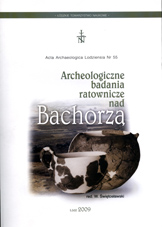JOVI OPTIMO FECIT - Jowiszowi Najlepszemu zgotowałem, czyli w sprawie miseczki terra sigillata z Żerkowa, woj. wielkopolskie
JOVI OPTIMO FECIT – for Jovi the Best I made, that is what concerns a terra sigillata bowl from Żerków, Great Poland voivodship
Author(s): Lubomira TyszlerSubject(s): Archaeology
Published by: Łódzkie Towarzystwo Naukowe
Summary/Abstract: A south Gallic bowl Drag. 27 (SIG DG Drag. 27b/c) from La Graufesenque comes from an accidental discovery in 1938 in Żerków, Great Poland voivodship. It was found in a double cinerary urn burial of the Przeworsk culture equipped with elements of armament (3rd group according to K. Godłowski) dated to phase B2a of the older Roman period. A trace of a stamp IO.FECI then translated as I(ovi) O(ptimo) Feci or IO(vi) Feci (for Jovi the Best I made) preserved on the bottom, inside the vessel, is an incomplete record of a nominal stamp which says [B]IO.FECI[T] used by a potter Bio from La Graufesenque who worked in the years 50-75/85. Black-brown colour of the bowl, instead of glittering red, is most probably a result of secondary overcolouring in consequence of thermal influence of the stake after the deposition of the bowl into the grave (?). Quality inspection carried on in workshops of La Graufesenque, especially in the years of the greatest prosperity, refused rejections to the trade (for instance refuse pits Fosse de Cirratus, Fosse Cluzel 15, Fosse de Gallicanus, Fosse de Bio, Fosse de L. Cosinus). The bowl was deposited in the grave complete, despite customs of the equipment destruction. In course of time, in the younger Roman period it would be under the same orders of destruction on the area of the Przeworsk culture. The collection gathered in a museum in Millau as well as in store-rooms at the site in La Graufesenque hitherto have not been completely discussed. An interesting part is, patterned upon the antique, a production from the 19th century by a potter Constans from Millau, that sometimes had a stamp OFF.CONSTANTIS AEMIL(ianensis).
Journal: Acta Archaeologica Lodziensia
- Issue Year: 2007
- Issue No: 53
- Page Range: 126-129
- Page Count: 4
- Language: Polish

